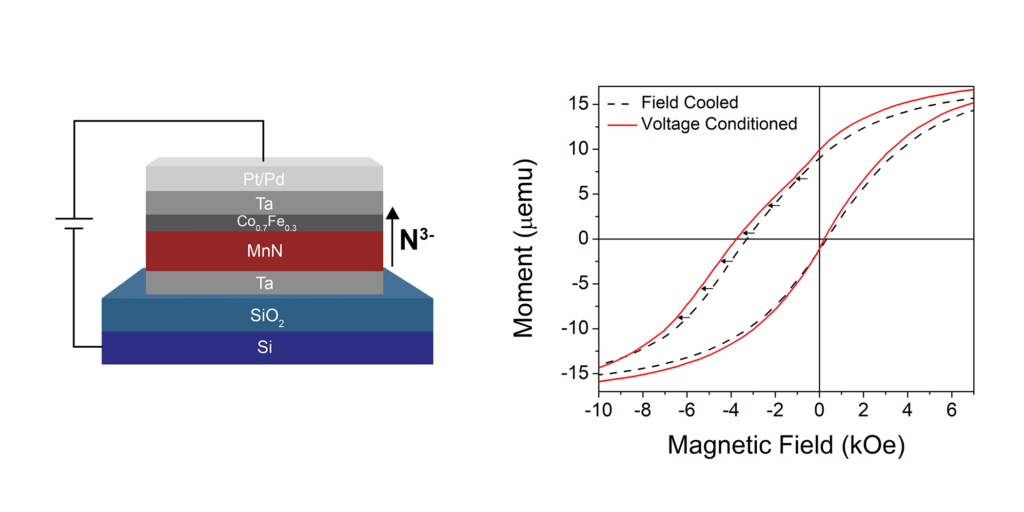Nitrogen-based Magneto-Ionic Manipulation of Nanomagnets Demonstrated

A new study has demonstrated an effective pathway for the manipulation of magnetic nanostructures using controlled nitrogen ion migration in a nonvolatile and energy-efficient manner. The study, led by Physics graduate student Christopher Jensen in Prof. Kai Liu’s group, is just published in ACS Nano.
Energy consumption in information and communications technologies has rapidly increased over the years, now accounting for over 10% of the world’s total energy usage already, and projected to surpass 20% within this decade. A key reason is that today’s electronics is not that energy-efficient, as it relies on charge current, which generates Joule heating effect.
Scientists have been working hard at finding alternative solutions to address this grand challenge. Methods aimed at controlling material properties using electric fields have attracted significant interests in recent years with the potential of enabling a new generation of nonvolatile, low-dissipation electronics, bypassing the need for electric currents in conventional systems.
One promising approach is the so-called magneto-ionics, an emerging field where ionic migration can be used to achieve atomic scale control of interfaces in magnetic nanostructures, and in turn modulate a wide variety of functionalities. The magneto-ionic effects can be tailored by using electric fields to drive ions, thus avoiding the use of the relatively inefficient electric current actuation. A particular topic of interest is the electric field manipulation of the so-called exchange bias effect across ferromagnet / antiferromagnet (FM/AF) interfaces, where the AF layer pins the FM layer, enabling control of magnetic configurations in practical devices. This effect is central to wide varieties of nanomagnetic and spintronic devices that exhibit low-energy-dissipation.
So far vast majority of the magneto-ionic studies are based on oxygen ions, which face certain limitations. In this study the researchers have demonstrated effective manipulation of exchange bias in Ta/MnN/CoFe/Ta thin films, through both chemical and electric field induced nitrogen ion migration. After films are exposed to elevated temperatures, nitrogen is observed to move out of the MnN layer and into the Ta layers in the structure due to the Ta chemical affinity to nitrogen. Under electric field application, N-ions can be driven back into the MnN layer, leading to a significant enhancement in exchange bias. This enhancement is associated with changes to the antiferromagnetic properties within the MnN layer and at the FM/AF interface, and is reversible under an electric field of opposite polarity for a longer duration.
The researchers used a variety of advanced techniques, including X-ray diffraction, scanning transmission electron microscopy, and polarized neutron reflectometry to provide direct evidence of structural and compositional changes that occur after field cooling and after voltage application. Correlating this evidence with magnetometry, the researchers were able to build an understanding of how nitrogen ions can be used to tailor exchange bias, showing its potential use in full electric control of exchange bias. Additionally, by employing electric fields, as opposed to relying on electric current, the researchers were able to demonstrate the potential of the magneto-ionic effect as an energy-efficient means to control spintronic devices, such as the magnetic tunnel junction, where exchange bias plays a central role in their functionality.
“Nitrogen’s application to the magneto-ionic effect is an exciting new area of research because of its compatibility with current silicon processing technologies”, said Jensen, “This study was a great opportunity to explore one important magnetic functionality that nitrogen ionic motion could be applied to, namely exchange bias, but changes in many magnetic properties are yet to be explored. I hope this work highlights nitrogen-based magneto-ionics and encourages others to investigate its potential applications”.
“This work demonstrates a novel nitrogen-based magneto-ionic effect”, said Liu, “It is particularly appealing as it allows reconfigurable electronics by transforming the all-important interfaces through ionic migration and enabling new magnetic functionalities”.
This work was done together with postdoctoral fellow Dr. Alberto Quintana in Liu’s group, in collaboration with Drs. Patrick Quarterman, Alexander Grutter, Purnima Balakrishnan, Huairuo Zhang, and Albert Davydov at the National Institute of Standards and Technology (NIST), and Prof. Xixiang Zhang at KAUST. It was supported in part by the SMART Center, sponsored by the Semiconductor Research Corporation and NIST, by the NSF, and by KAUST.
